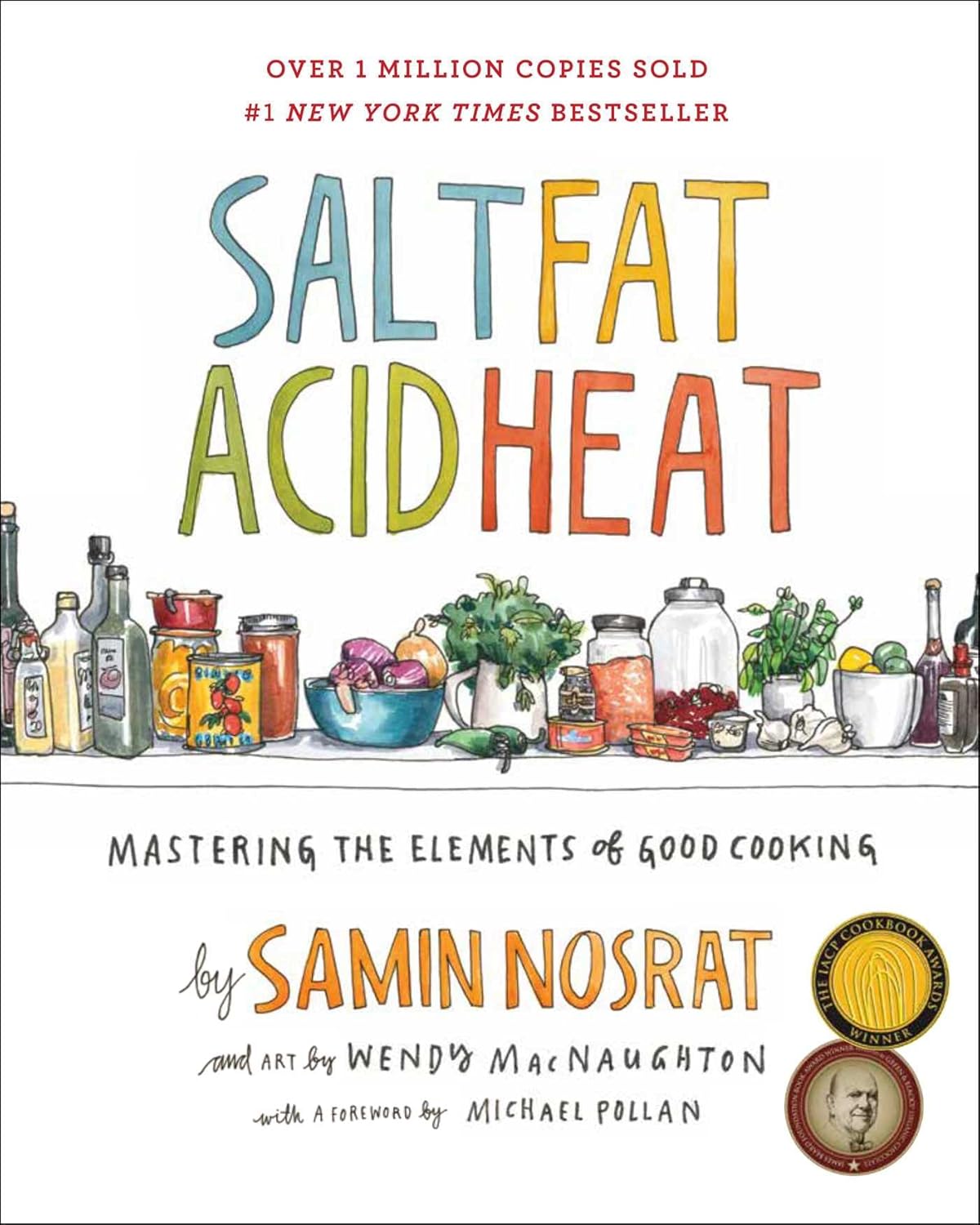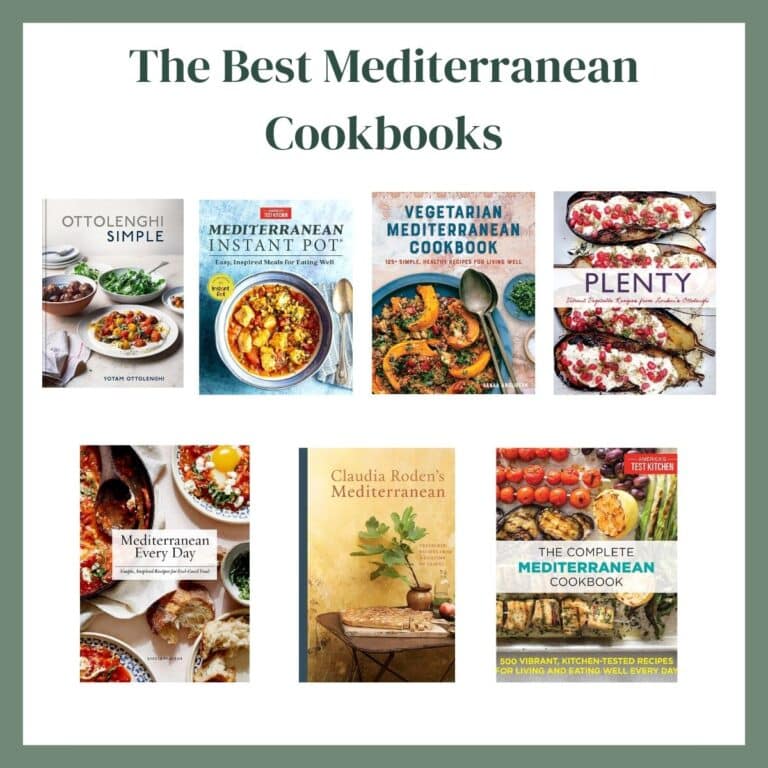Salt, Fat, Acid, Heat Review
Salt, Fat, Acid, Heat is a vibrant, practical guide to understanding the core elements of cooking. Samin Nosrat distills the art of good food down to four essential elements: salt, fat, acid, and heat. Her approach is both instructional and empowering, aiming to help cooks of all levels master these fundamentals and become more intuitive, confident cooks. With delightful illustrations by Wendy MacNaughton, the book transforms cooking from a formulaic process into an approachable, fun experience. The concept is easy to apply to any recipe, making this an excellent cookbook beyond recipes- it really teaches you to think about what you are making. The Salt, Fat, Acid, Heat recipes are easy to learn from and adjust to nearly anything you make.

[book-info]
Author
Samin Nosrat, a chef, teacher, and writer, has worked with some of the best in the culinary world, including at Berkeley’s Chez Panisse. Known for her warmth and down-to-earth style, she’s also recognized for her Netflix series based on the book. Nosrat’s passion for helping people enjoy cooking shines through, and her culinary background brings a wealth of insight to her explanations of technique and flavor.
Audience
The book appeals to a broad spectrum of readers, from novices eager to move beyond following recipes to seasoned cooks seeking a deeper understanding of food science. Beginners will appreciate Nosrat’s warm, encouraging tone and her ability to make daunting topics, like balancing flavors, feel manageable. Intermediate cooks will find value in her explanations of why certain techniques work and how to apply them in various contexts. Even professional chefs can glean new insights from her emphasis on mastering the fundamentals. In short, if you love food and want to cook better—regardless of your current skill level—this book offers something for you.
Mission
Nosrat’s mission is to empower readers to cook with confidence and creativity by understanding the principles that make food delicious. Rather than providing a simple collection of recipes, she introduces readers to the universal building blocks of good cooking: salt enhances flavor, fat adds richness, acid balances tastes, and heat transforms ingredients. Through engaging explanations, hands-on techniques, and illustrative examples, she encourages readers to experiment and trust their instincts in the kitchen. Her ultimate goal is to demystify cooking, making it an intuitive, joyful process that anyone can master. This philosophy of empowerment is at the heart of the book and is what makes it stand out in the crowded world of cookbooks.
Standout Features that I Liked
- The emphasis on technique and intuition in Salt, Fat, Acid, Heat is its standout feature.
- The book’s illustrations and Nosrat’s approachable voice make it easy to grasp complex concepts like balancing flavors or cooking temperatures.
- There's a beautiful chart for flavors that I love referring to.
- Nosrat’s passion for cooking is contagious, and her way of explaining complex ideas is refreshing.
- The book’s format encourages creativity, making it a useful and engaging reference for any kitchen.
FAQ
The book contains recipes that highlight the four elements: salt, fat, acid, and heat. While there are classic dishes like roast chicken and Caesar salad, many recipes are templates designed to teach technique rather than rigid formulas. Expect a mix of global flavors, reflecting Nosrat’s diverse culinary influences.
Yes, as most recipes are meant for learning techniques. The timing depends on the dish. Some, like vinaigrettes, are quick and straightforward, while others, like braised meats, require a longer time commitment. The beauty of this book is that it teaches you how to plan and adapt recipes to suit your schedule.
It focuses on basics. The approachable language, step-by-step illustrations, and focus on fundamentals make it perfect for those just starting their culinary journey. Nosrat’s emphasis on learning through practice means beginners can dive in without fear of failure
There are wonderful illustrations throughout. They are very helpful for the techniques described. These visuals are not only functional but also add a playful, artistic touch that aligns with the book’s creative spirit.
No fancy gadgets are required. The focus is on classic tools like a sharp knife, a sturdy skillet, and a baking dish. Nosrat encourages readers to work with what they have while understanding the value of investing in quality basics over time.
Most recipes use familiar ingredients like olive oil, citrus, and salt, making it accessible for everyday cooking. However, some recipes, such as those with international flavors, may require trips to specialty stores or online shopping.
Many recipes are quite flexible, designed to let cooks experiment, so time varies by approach.
No, this cookbook focuses on principles and flavor over dietary details.
Yes. Many recipes, such as soups, salads, and roasted vegetables, can be customized to suit picky eaters or adventurous diners alike. The principles Nosrat teaches are universal, making it easy to adapt dishes for any family meal.
No, it is not a part of a series.
Yes, I read this before bed for a while. Since it's informational, it's great to read and digest, then try (and actually digest).
This book is a keeper. I have re-read it a couple times over the years to help me continue to grow my culinary knowledge.
Final Verdict: A Permanent Addition?
Not only is this permanently in my kitchen, but it's a gift I have given to several people when they start living on their own or showing interest in cooking. This is the kind of book that will shift the way you cook and develop your own recipes.
If You Are Interested In This Book, You Might Also Like:
If you enjoy Salt, Fat, Acid, Heat, The Food Lab by J. Kenji López-Alt offers another scientific yet practical take on cooking. You can also check out Fermented Vegetables, which teaches the science behind fermentation.









